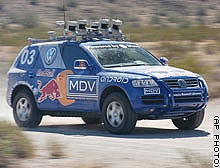Three vehicles beat the standard in $2 million robot race
Three robotic vehicles cruised past the finish
line Saturday in a Pentagon-sponsored race across the rugged Mojave desert,
giving scientists hope that robots could one day wage battles without
endangering soldiers.

"The impossible has been achieved," cried Stanford University's Sebastian Thrun, after the university's customized Volkswagen crossed first. Students cheered, hoisting Thrun atop their shoulders.
Also finishing was a converted red Hummer named "H1ghlander" and a Humvee named "Standstorm" from Carnegie Mellon University. The Stanford robot dubbed "Stanley" overtook the top-seeded H1ghlander at the 102-mile mark of the 132-mile course.
"I'm on top of the world," said Carnegie Mellon robotics professor William "Red" Whittaker, who said a mechanical glitch allowed Stanley to pass H1ghlander.
I hope someone got video of one robot passing another!
The Pentagon's Defense Advanced Research Projects Agency, or DARPA, plans to award $2 million to the fastest vehicle to cover the race in less than 10 hours. The taxpayer-funded race was intended to spur innovation and development of robots that could be used on the battlefield without remote controls.
------------
Last year's much-hyped inaugural robot race ended without a winner when all the self-navigating vehicles broke down shortly after leaving the starting gate.
Carnegie Mellon's Sandstorm chugged the farthest at 71/2 miles. Of the 23 robots that competed Saturday, 15 vehicles failed to navigate the entire 132-mile course, but most still managed to beat Sandstorm's mileage last year.
------------
Vehicles have to drive on rough, winding desert roads and dry lake beds filled with overhanging brush and man-made obstacles. The machines also must traverse a narrow 1.3-mile mountain pass with a steep drop-off and go through three tunnels designed to knock out their GPS signals.
------------
The so-called Grand Challenge race is part of the Pentagon's effort to cut the risk of casualties by fulfilling a congressional mandate to have a third of all military ground vehicles unmanned by 2015.
The military currently has a small fleet of autonomous ground vehicles stationed in Iraq and Afghanistan, but the machines are remotely controlled by a soldier who usually rides in the same convoy. The Pentagon wants to eliminate the human factor and use self-thinking robotic vehicles to ferry supplies in war zones.
It’s astonishing to see what only 2 years of a competition like this can produce.
Posted: Sat - October 8, 2005 at 07:19 PM